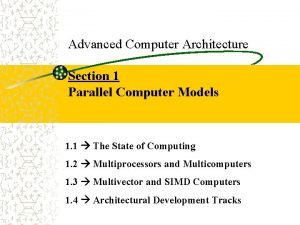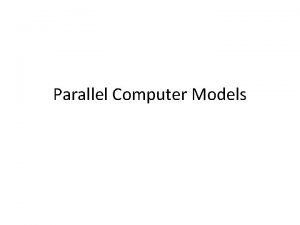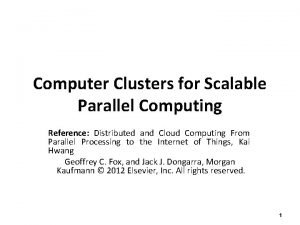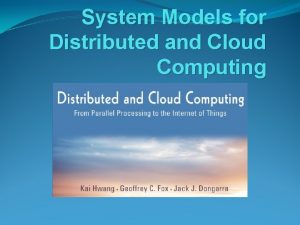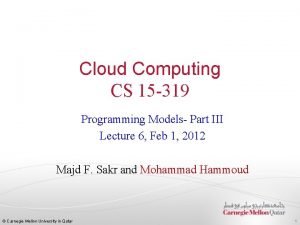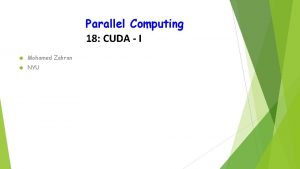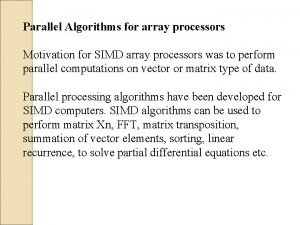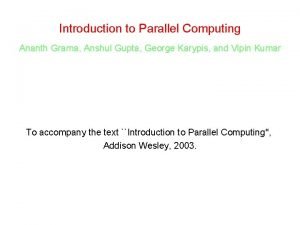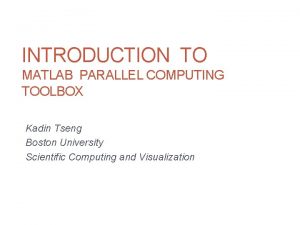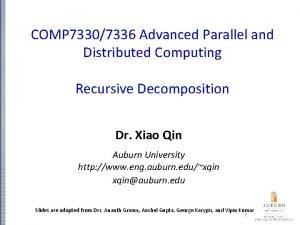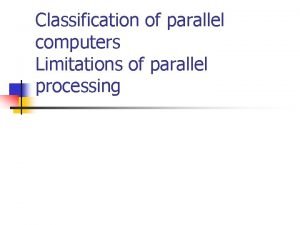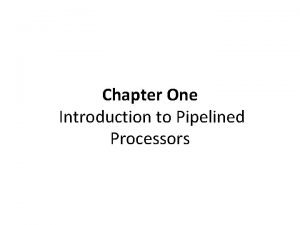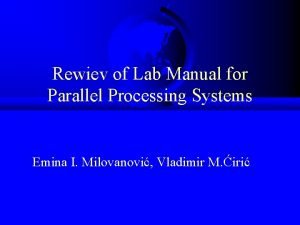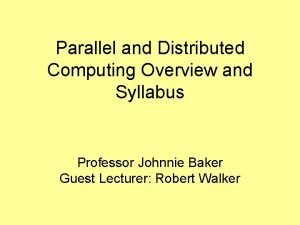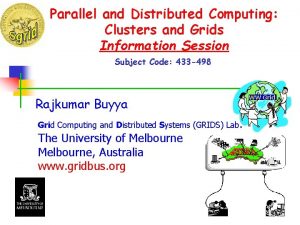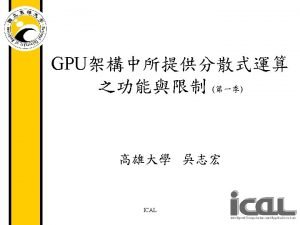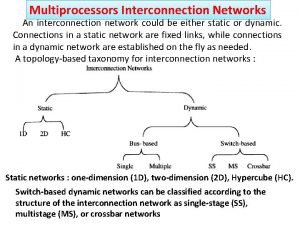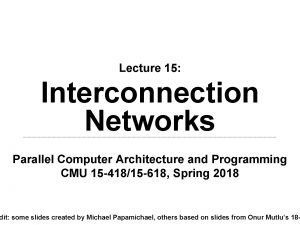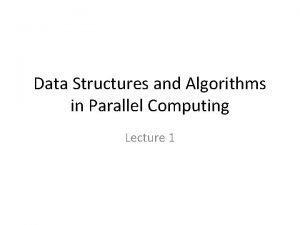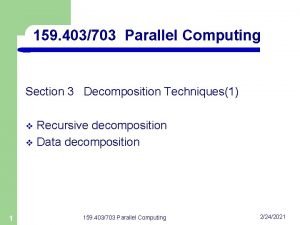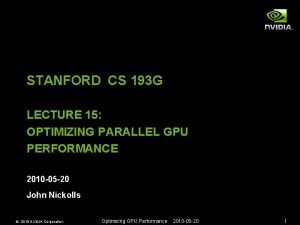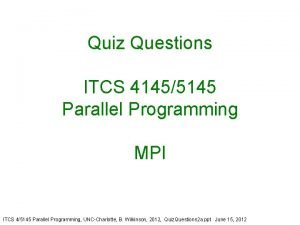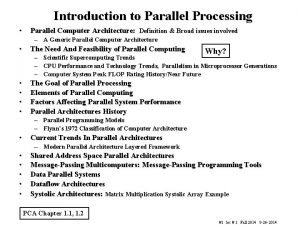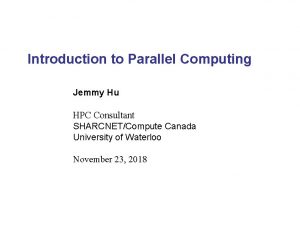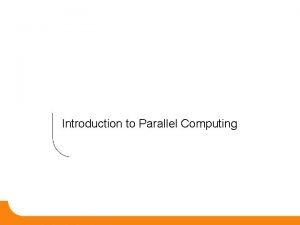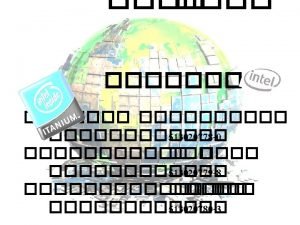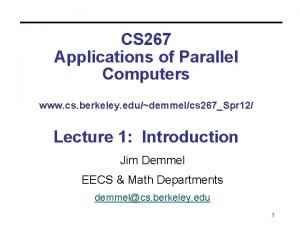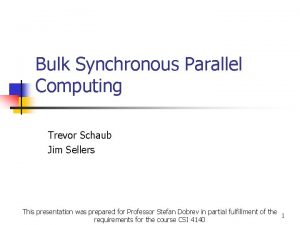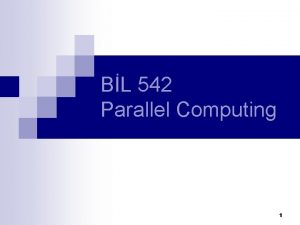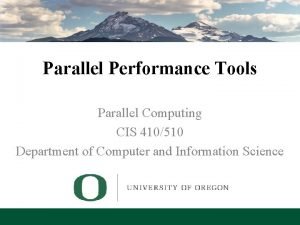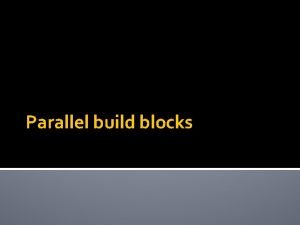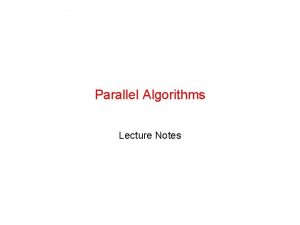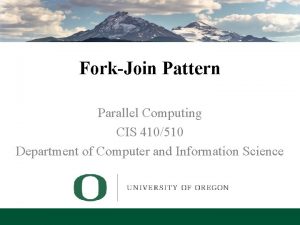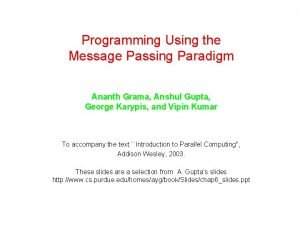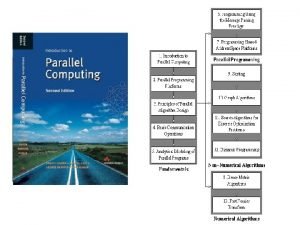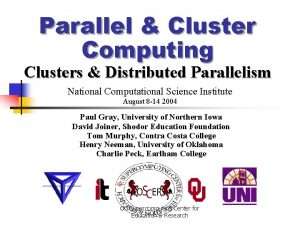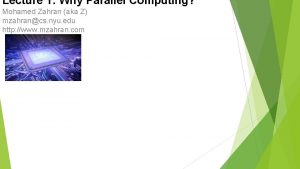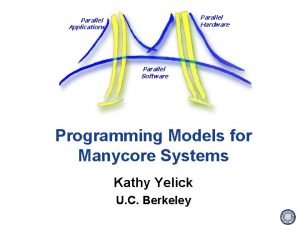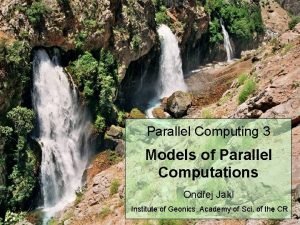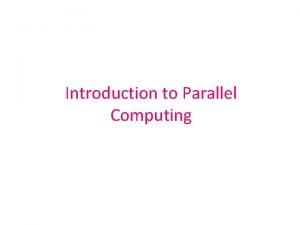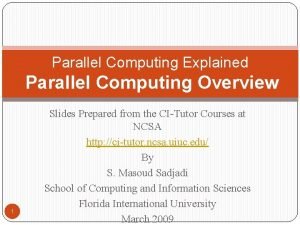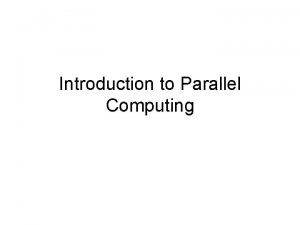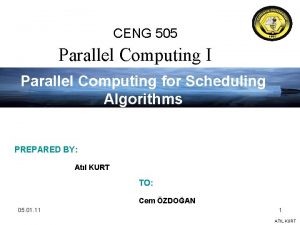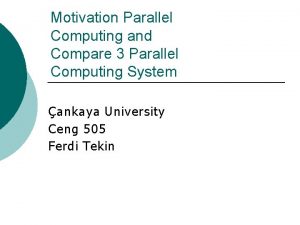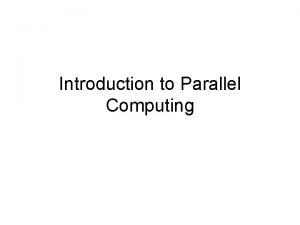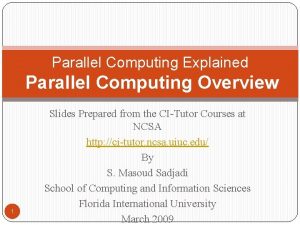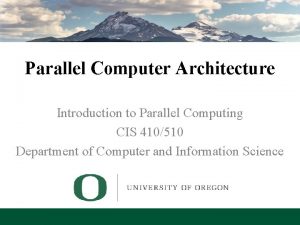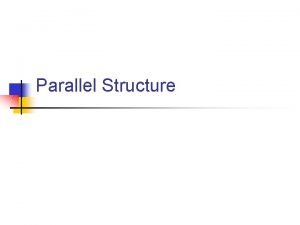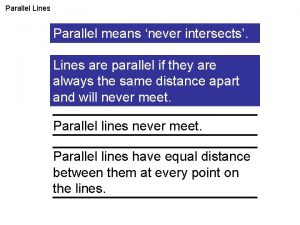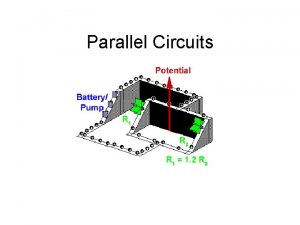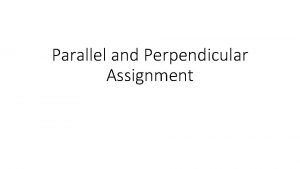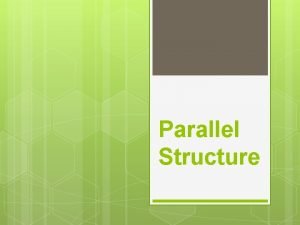Parallel Computer Models THE STATE OF COMPUTING Computer






































































- Slides: 70

Parallel Computer Models

THE STATE OF COMPUTING Computer Development Milestones • Prior to I 945, computers were made with mechanical or electromechanical pans. • The earliest mechanical computer can be traced back to 5110 BC in the form of the abacus used in China. The abacus is manually operated to perform decimal arithmetic with carry Propagation digit by digit. • Blaise Pascal built a mechanical adder and subtractor in France in 1642. Charles Babbage designed a difference engine in England for polynomial evaluation in 1827. • Konrad Zuse built the first binary mechanical computer in Germany in 1941. • Howard Aiken proposed the very first electromechanical decimal computer, which was built as the Harvard Mark I by IBM in 1944. • Both Zuse’s and Aiken‘s machines were designed for generalpurpose computations.


• 1 Million = 10 Lakhs = 1 followed by 6 Zeros = 1, 000 • 10 Million = 1 Crore • 100 Million = 10 crore • 1000 Million = 100 Crore = 1 Billion





Elements of Modern Computers

Evolution of Computer Architecture


Flynn’s classification 1. SISD(single instruction stream over a single data stream) 2. SIMD (single instruction stream over a multiple data stream) 3. MIMD(multiple instruction stream over a multiple data stream) 4. MISD(multiple instruction stream over a single data stream)

Flynn’s classification • Of the four machine models, most parallel computers built in the past assumed the MIMD model for general purpose computations. • The SIMD and MISD models are more suitable for special-purpose computations. • For this reason, MIMD is the most popular model, SIMD next, and MISD the least popular model being applied in commercial machines



Development Layers

System Attributes affecting Performance • The ideal performance of a computer system demands a perfect match between 1. Machine capability 2. Program behavior.

System Attributes affecting Performance • Machine capability can be enhanced with better hardware technology, innovative architectural features, and efficient resources management. • However, program behavior is difficult to predict due to its heavy dependence on application and run-time conditions

System Attributes affecting Performance • There also many other factors affecting program behavior, including 1. Algorithm design, 2. Data structures, 3. Language efficiency, 4. Programmer skill, and 5. Compiler technology

System Attributes affecting Performance • The simplest measure of program performance is the turnaround time?

System Attributes affecting Performance • The simplest measure of program performance is the turnaround time which includes 1. disk and memory accesses, 2. input and output activities, 3. compilation time, 4. OS overhead, and 5. CPU time

System Attributes affecting Performance Clock Rate and CPI • The CPU of today‘s digital computer is driven by a clock with a constant cycle time T • The inverse of the cycle time is the clock rate (f= 1/T).

CPU Performance © Essentially all computers are constructed using clock (all called ticks, clock periods, clocks, cycles, or clock cycles) running at a constant rate. u u Clock rate: today in GHz Clock cycle time: clock cycle time = 1/clock rate © Thus, the CPU time for a program can be expressed two ways: 1 Or, 2 Computer Architecture- 23

CPU Performance © We can also count the number of instructions executed – the instruction path length or instruction count (IC). © If we know the number of clock cycles and IC, then the average number of clock cycles per instruction (CPI). © CPI is computed as 3 © Thus, clock cycles can be defined as IC × CPI, this allows us to use CPI in the execution time formula: Substituting Equation 3 in Equation 1 we get 4 Computer Architecture- 24

CPU Performance © The pieces fit together of CPU time . † Processor performance is dependent upon three characteristics: instruction count, clock cycles per instruction and clock cycle (or rate). Computer Architecture- 25

System Attributes affecting Performance

System attributes

Problem 1

Problem 1 Solution

Problem 2

Problem 2 solution

Problem 3 Determine CPI and execution time for this program


MIPS rate • The processor speed is often measured in terms of million instructions per second (MIPS). • Let C be the total number of clock cycles and T be cpu time needed to execute a given program • MIPS rate varies with respect to a number of factors, including the clock rate , the instruction count and the CPI of a given machine

Floating Point Operations per Second(flops) • gflops, • teraflops or • petaflops.

Programming Environments • Implicit Parallelism • Explicit Parallelism

Programming Environments • Implicit Parallelism:

Problem 4 • You are on the design team for a new processor. The clock of the processor runs at 200 MHz. The following table gives instruction frequencies for Benchmark B, as well as how many cycles the instructions take, for the different classes of instructions. For this problem, we assume that (unlike many of today's computers) the processor only executes one instruction at a time. Instruction Type Frequency Cycles Loads & Stores 30% 6 cycles Arithmetic Instructions 50% 4 cycles All Others 20% 3 cycles Calculate the CPI for Benchmark B.

Problem 4 solution • If we say that there are 100 instructions, then: 30 of them will be loads and stores. 50 of them will be arithmetic instructions. 20 of them will be all others. (30 * 6) + (50 * 4) + (20 * 3) = 440 cycles/100 instructions Therefore, there are 4. 4 Cycles per instruction.

Problem 4 • Suppose we have two implementations of the same instruction set architecture. Computer A has a clock cycle time of 250 ps and a CPI of 2. 0 for some program, and computer B has a clock cycle time of 500 ps and a CPI of 1. 2 for the same program. Which computer is faster for this program and by how much?

Solution




NUMA Model

COMA Model


Distributed memory multicomputers

Taxonomy of MIMD Computers


Vector Super. Computer


SIMD Computers

Program and Network Properties • CONDITIONS OF PARALLELISM Data and Resource Dependence: • The ordering relationship between statements indicated by the data dependence. Five types of data dependence are defined below 1. Flow dependence 2. Antidependence 3. Output dependence 4. I/O dependence 5. Unknown dependence


Program and Network Properties

Program and Network Properties


Problem 1 • Perform a data dependence analysis on each of the following Fortran program fragments. Show the dependence graphs among the statements with justification

Problem 1 • Perform a data dependence analysis on each of the following Fortran program fragments. Show the dependence graphs among the statements with justification

Problem 2 • Perform a data dependence analysis on each of the following Fortran program fragments. Show the dependence graphs among the statements with justification

Problem 2 • Perform a data dependence analysis on each of the following Fortran program fragments. Show the dependence graphs among the statements with justification

Control Dependence

Bernstein’s Condition These three conditions are known as Bernstein’s Condition.

Detection of parallelism in a program using Bernstein's conditions • Consider the simple case in which each process is a single HLL statement. We want to detect the parallelism embedded in the following five statements labeled PI, P 2, P 3, P 4, and P 5 in program order

Detection of parallelism in a program using Bernstein's conditions

Detection of parallelism in a program using Bernstein's conditions

Detection of parallelism in a program using Bernstein's conditions

PROGRAM PARTITIOHI NG AND SCHEDULING • Grain Sizes and Latency

 Parallel computer models
Parallel computer models Parallel computer models
Parallel computer models Computer clusters for scalable parallel computing
Computer clusters for scalable parallel computing What is the difference between models and semi modal
What is the difference between models and semi modal Explain system models for distributed and cloud computing
Explain system models for distributed and cloud computing Cloud computing programming models
Cloud computing programming models Greg ganger
Greg ganger Conventional computing and intelligent computing
Conventional computing and intelligent computing Matlab gpu parallel computing
Matlab gpu parallel computing Parallel computing nyu
Parallel computing nyu Simd parallel algorithms
Simd parallel algorithms Motivating parallelism
Motivating parallelism Matlab spmd
Matlab spmd Recursive decomposition example
Recursive decomposition example Parallel and distributed computing lecture notes
Parallel and distributed computing lecture notes Gustafson’s law
Gustafson’s law Unifunction and multifunction pipeline
Unifunction and multifunction pipeline Parallel computing lab manual
Parallel computing lab manual Parallel and distributed computing course outline
Parallel and distributed computing course outline Cluster in parallel and distributed computing
Cluster in parallel and distributed computing Cuda
Cuda Network interconnection studies
Network interconnection studies Cmu parallel computing
Cmu parallel computing Data structures for parallel computing
Data structures for parallel computing Exploratory decomposition
Exploratory decomposition All-to-all personalized communication
All-to-all personalized communication Recursive decomposition in parallel computing
Recursive decomposition in parallel computing Cs193 stanford
Cs193 stanford Parallel computing quiz
Parallel computing quiz Parallel computing definition
Parallel computing definition Parallel computing
Parallel computing Parallel computing
Parallel computing Intel itanium 2
Intel itanium 2 Cs267 berkeley
Cs267 berkeley Trevor schaub
Trevor schaub Parallel computing
Parallel computing In parallel computing
In parallel computing Parallel computing
Parallel computing In parallel computing
In parallel computing Parallel distributed computing
Parallel distributed computing In parallel computing
In parallel computing Introduction to parallel computing ananth grama ppt
Introduction to parallel computing ananth grama ppt Introduction to parallel computing ananth grama
Introduction to parallel computing ananth grama Distributed, parallel, and cluster computing
Distributed, parallel, and cluster computing Parallel computing nyu
Parallel computing nyu Example for like parallel force
Example for like parallel force Tiny elevation of hill like structure
Tiny elevation of hill like structure Parallelism refers to
Parallelism refers to Parallel construction.
Parallel construction. Parallel structure means using the same pattern of
Parallel structure means using the same pattern of Serial in serial out shift register truth table
Serial in serial out shift register truth table Parallel lines definition
Parallel lines definition Hát kết hợp bộ gõ cơ thể
Hát kết hợp bộ gõ cơ thể Bổ thể
Bổ thể Tỉ lệ cơ thể trẻ em
Tỉ lệ cơ thể trẻ em Voi kéo gỗ như thế nào
Voi kéo gỗ như thế nào Glasgow thang điểm
Glasgow thang điểm Chúa sống lại
Chúa sống lại Các môn thể thao bắt đầu bằng tiếng chạy
Các môn thể thao bắt đầu bằng tiếng chạy Thế nào là hệ số cao nhất
Thế nào là hệ số cao nhất Các châu lục và đại dương trên thế giới
Các châu lục và đại dương trên thế giới Công thức tính thế năng
Công thức tính thế năng Trời xanh đây là của chúng ta thể thơ
Trời xanh đây là của chúng ta thể thơ Cách giải mật thư tọa độ
Cách giải mật thư tọa độ 101012 bằng
101012 bằng độ dài liên kết
độ dài liên kết Các châu lục và đại dương trên thế giới
Các châu lục và đại dương trên thế giới Thể thơ truyền thống
Thể thơ truyền thống Quá trình desamine hóa có thể tạo ra
Quá trình desamine hóa có thể tạo ra Một số thể thơ truyền thống
Một số thể thơ truyền thống
